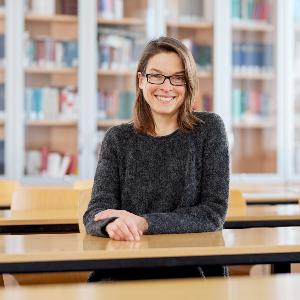Touching the soul of a language
14 Dec 2023
Slavist Barbara Sonnenhauser, a new face at LMU, is an expert in language change and multilingualism.
14 Dec 2023
Slavist Barbara Sonnenhauser, a new face at LMU, is an expert in language change and multilingualism.

examines how linguistic features have spread. | © Stephan Höck/LMU
Language can betray you. We use it every day, yet it gives away more than the people who speak it might imagine. For linguistic researchers, the words people choose and the structure of their sentences are pathways to the past. “Language is transmitted from generation to generation,” Barbara Sonnenhauser says. “What interests me is how it is anchored in the history of its speakers. How did linguistic characteristics spread? Who spoke to whom and when? Why – and how – did they speak? What external influences were there?” These questions lead the Slavist from the analysis of linguistic characteristics to socioeconomic and historical occurrences that can provide her with explanations. “Certain political constellations, for example, may have made it possible for different speech communities to come into contact with each other at all – because they were trading or were integrated in given administrative structures.”
Sonnenhauser has been Professor of Slavic Philology at the Faculty of Languages and Literature since April 2023. The appointment brings her back to the place where she herself studied: In the late 1990s, she read Slavic studies, Eastern and Southern European history and Turkish studies at LMU. “That is how I came to be interested in Southeast Europe and everything linguistic and cultural that happens there.”
She had no hesitation in pursuing these interests. “And doors opened for me,” she says, looking back. She first earned her doctorate at Leipzig University before returning to Munich to qualify as a professor. After a period spent teaching and researching at the University of Vienna, she then moved to the University of Zurich.
Migration is a driver of language change. People take their language with them and use it in new contexts.Barbara Sonnenhauser
In a number of research projects, Sonnenhauser applied herself to Slavic varieties in the Balkans. “There are many languages here that are relatively ‘unslavic’. History gives us explanations for this development: There were all kinds of contact with Greek, Albanian and the Romance varieties. These led to a measure of linguistic convergence, with the result that we today see similar structures across all these language families.”
Multilingualism is another key field of the professor’s research. To take just one example: She and a project team from the University of Zurich and LMU have investigated how Albanian, which is not a Slavic language, is today used as the heritage language by people who have migrated to Germany and Switzerland, and how it has changed over the generations. “Migration is a driver of language change. People take their language with them and use it in new contexts.” Studies such as this one give researchers fundamental insights into what happens when speech communities migrate. But it also helps them understand the historical dynamics of changes in languages of which no speakers are still alive today.
To find answers to research questions going back to the 16th century, Sonnenhauser works with historical manuscripts and authentic historical voice recordings. This work involves using the possibilities afforded by digital text corpora in order to analyze characteristics across multiple texts. In light of current political conflicts and diverging national interests, conducting field research is not always easy. For precisely this reason, however, the linguist believes it is all the more important to engage with Slavic languages and their dynamics. In this way, she says, mere assertions can be confronted with scientific insights.
Munich has one of the biggest and most exciting Slavic studies departments in existence. It also has room for the science of linguistics. Virtually all Slavic languages are represented here.Barbara Sonnenhauser
Asked what prompted her return to LMU, Barbara Sonnenhauser’s response is instantaneous: “Slavic studies,” she smiles. “Munich has one of the biggest and most exciting Slavic studies departments in existence. It also has room for the science of linguistics. Virtually all Slavic languages are represented here, at least as the subject of lectures. As a result, they can be drawn on for teaching purposes, because students have the option of signing up for or just sitting in on courses.” For Sonnenhauser herself, Slovenian fulfilled this function during her studies. She describes it as “a very fascinating Slavic language, because it is relatively atypical.” LMU, she adds, is “one of the few universities where this is possible”.
The Slavic language expert is equally excited about the “diversity of philologies at LMU”, which gives her countless points of reference. “The Slavic languages do not exist in a vacuum,” she says. “They have a long history that is tied up with Western Eurasia, but also with Northern Europe. If that is what you are interested in, it needs to be embedded in a wider context, and that is what you find at LMU. Our faculty also has Albanology and Finno-Ugric studies, for example. Where else will you get that?”
Barbara Sonnenhauser et al.: Pairing peers and pears. In: Language Dynamics and Change 2023